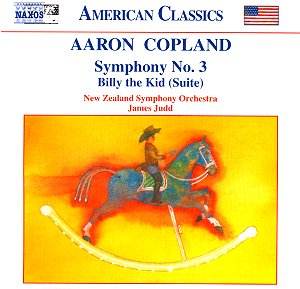Anyone buying this disc, liking it, and looking to
complement their purchase with Symphonies 1 and 2 will probably be frustrated.
Copland’s No. 1 was the Symphony for Organ and Orchestra of 1924,
and his No. 2 the so-called Short Symphony which dates from 1933.
Neither can be thought of as a conventional essay in symphonic form,
but with the present work, which was completed in 1946, the composer
adopted a much more traditional symphonic method.
The work is in four movements, of which the last two
play without a break. The music is conceived in Copland’s most immediately
recognisable American style, though why these rather angular melodies,
this very clean and open texture plus a kind of innocence and simplicity
should be so typically American is another matter. It’s true that the
very open and uncluttered orchestral sound which Copland conjures up
does evoke the vastness of the American landscape, perhaps even more
so for someone like myself who has never seen it. And Copland’s "…gift
to be simple", so memorably put to use in his Old American Songs
and elsewhere, is equally evocative, even if only in a vicarious way,
of the plain and open-hearted optimism of early American settlers and
their church.
The first movement opens with a calm, rather large-limbed
melody which is treated to much development, both here and later in
the work, and which is the material for the extremely beautiful and
tranquil first movement coda. The second movement is a somewhat raucous
scherzo with a more peaceful trio section, and the slow movement, perhaps
the most difficult from the listener’s point of view, also contains
contrasting material. The finale steals in with the theme from the well-known
Fanfare for a Common Man, and much of finale is based on that
work. It certainly provides a grand and sonorous close, though why the
composer decided to revisit the earlier work in such an extensive way
in a symphonic context is unclear.
The ballet Billy the Kid dates from 1938, and
tells the story of the famous outlaw from the point where he begins
his lawless life to avenge the murder of his mother to his own death
at the hands of the sheriff Pat Garrett, and all very clearly set on
the American prairie. Indeed, the opening of Billy the Kid inhabits
very much the same kind of sound world as the opening of the symphony.
The only real difference between the Suite, presented here, and the
complete work, is a fairly significant cut towards the end.
With this disc the New Zealand Symphony Orchestra makes
its first appearance in my collection, but I’ll be looking out for it
in future. It’s a most creditable group, with an excellent string section,
though perhaps just slightly lacking in the weight some passages of
this music demand. The orchestra is very well recorded in what I assume
is their home, and the booklet features an informative essay by Peter
Quinn. The only thing I missed in an otherwise excellent production
was a detailed synopsis of the twenty-one minutes of Billy the Kid
and separate tracking to help the listener know where he is.
James Judd, the orchestra’s Music Director, has had
ample time to assimilate the American style, as he was Music Director
of the Florida Philharmonic for some fourteen years. He paces both works
admirably and the required atmosphere – the score of the first movement
of the symphony is marked "…with simple expression" – is well
established. The one slight weakness I sensed, especially when compared
to other, more authentic performances, such as Mata (EMI, Mexican conductor,
American orchestra) or especially Bernstein (Sony or DG), is the slight
lack of weight and power already mentioned. The finale is convincing
enough but the playing lacks the steel of the finest rivals, those textures
already mentioned not quite clean or open enough. Listening to Slatkin
in Billy the Kid (EMI) brings similar slight doubts, but I wouldn’t
want to make too much of them, because these performances are extremely
convincing on their own terms, and nobody buying this disc, particularly
– need one say it? – at the price, will be disappointed. I still cherish
memories, however, of Copland conducting his third symphony in concert
in London in the early seventies, a huge smile on his face as he encouraged
the London Symphony Orchestra to an ever longer, ever louder, final
crescendo.
William Hedley


![]() See
what else is on offer
See
what else is on offer 